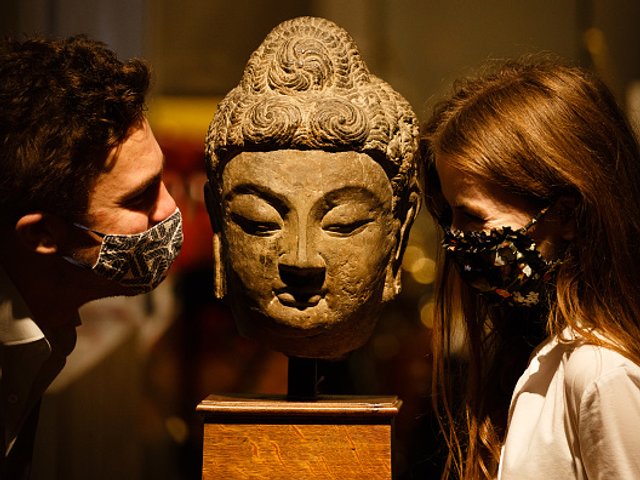Four years ago, the UK government compelled companies with more than 250 employees to submit salary data, exposing the extent of the gender pay gap.
So how have the country’s biggest auction houses fared since then? And has the pandemic eased or exacerbated existing fault lines? On the whole, there has been little progress since 2018 in terms of the figures, which are based on median hourly earnings and include part-time workers.
At Bonhams, the figures worsened in 2020/21, when the UK pay gap grew to 52.4%, meaning women earned 48p for every £1 that men earned, while the percentage of women in the highest paid quartile plunged from 25.3% in 2018/19 to zero—there were no female employees at all in the top three of four pay brackets. In 2017/18, Bonhams’ pay gap was 36.7% and in 2018/19 women earned 38.7% less. (No reporting was required in 2019/20 due to the pandemic.)
However, a spokesperson for Bonhams points out that the 2020/21 figures are a “snapshot” of all UK employees on full pay on 5 April 2020, which skewed the firm’s figures—only 16 staff (all technology or gallery staff) were left on full salary in the UK that day. “At that time, 99.9% of staff were either on furlough or had taken reduced hours with reduced salaries,” she says. Sotheby’s and Christie’s figures were not similarly affected; Sotheby’s says it had not yet introduced furlough measures by 5 April 2020, while Christie’s topped up all furlough payments but its figures would have been skewed by salary reductions at the time, although these were later repaid in full. (Bonhams did not top up furlough salaries).
Worldwide, Bonhams is doing much better. In 2020, 70% of its new hires were women; while the firm also established a leadership team in the US, of which 89% are women. As a result, in 2020/21, the global pay gap closed by 7.1% dropping from 33.5% in the last survey to 26.4%. The percentage of women in the upper quartile also increased from 8.7% to 46.7%.
At Bonham’s the percentage of women in the highest paid quartile plunged from 25.3% in 2018/19 to zero
Bonhams is also attempting to close the gap from the bottom up. In September 2021, it established its graduate recruitment programme, of which 66% of its first contingent are female. Meanwhile, take up for a new auctioneer training programme that encourages women has been “phenomenal”, the firm’s spokesperson says. Last month, the firm appointed India Phillips as managing director of Bonhams UK, heading up its UK senior management team, which now comprises five women and four men.
The next figures (2021/22) are due on 4 April, and only Christie’s has filed its report early. Here, the pay gap now stands at 25.6%. There has been little improvement since reporting began; in 2017/18 women earned 25% less, and—to compare with other firms’ latest figures—in 2020/21 the gap was 24.4%.
A spokesperson says the main reason for the gap is that “70% of the global workforce is female”. She adds: “Since April we have both promoted existing colleagues into senior positions and hired others at a senior level.” Key appointments to the senior leadership team include Bonnie Brennan, who was promoted to president in the Americas in March, and Rebecca Yang, who became chair in China in August.
There is some progress at Christie’s. In 2021/22, 51% of employees in the top quartile are women (compared with 43% in 2017/18) and the bonus pay gap is now 0% (compared with 2017/18 when it was 40.3%). Representation at executive management level has also improved—the firm now has a 35% female/65% male split, though this is short of the 50/50 parity Christie’s chief executive Guillaume Cerutti pledged by 2020. Cerutti is aiming this year to “move towards at least 40/60”, the spokesperson says.
Graduate focus
As at Bonhams, there is a focus on graduates and apprentices at Christie’s “to help broaden our talent base”, according to the spokesperson. In the US, Christie’s relaunched its summer internship programme with a class that was 63% female and 60% ethnically diverse. In March, the company launched its Equity, Diversity and Inclusion Fund, partnering with four organisations including the UK’s Art History Link Up, which aims to make the subject accessible to young people from different backgrounds.
At Sotheby’s, the pay gap has marginally worsened since 2017/18 when it stood at 22.2%. In 2021/22, that figure stood at 24.9% (meaning women earned 75p for every pound men earned). The percentage of women in its top quartile has grown slightly from 47.6% to 49.6%, but the bonus pay gap has also risen from 16.7% to 20.3%. Excluding Sotheby’s chief executive Charles Stewart, there are 12 people on its executive committee, six of whom are female. A Sotheby’s spokesperson says the pandemic has had “no effect” on its gender pay gap “as we remain focused on recruiting and developing staff, and supporting women as they rise to greater responsibility and compensation in the organisation”.
Maternity benefits and childcare allowances have been notoriously poor at auction houses. Sotheby’s is investing in these—the spokesperson says that “due to the steps we have been putting in place through employee resource groups, family-friendly policies and benefits to support our employees at crucial moments of their lives and careers, we are expecting to see positive changes to our gender pay gap”.
By comparison, public sector organisations appear beacons of gender equality. In 2017/18, the Victoria and Albert Museum paid women 7.2% less; it now pays women 14.1% more. At the Tate, women are paid the same as men (down slightly from the 2.4% advantage they had in 2017/18), while, at the Royal Academy of Arts, women earn 2% more than men compared with 1% less in 2017/18.





